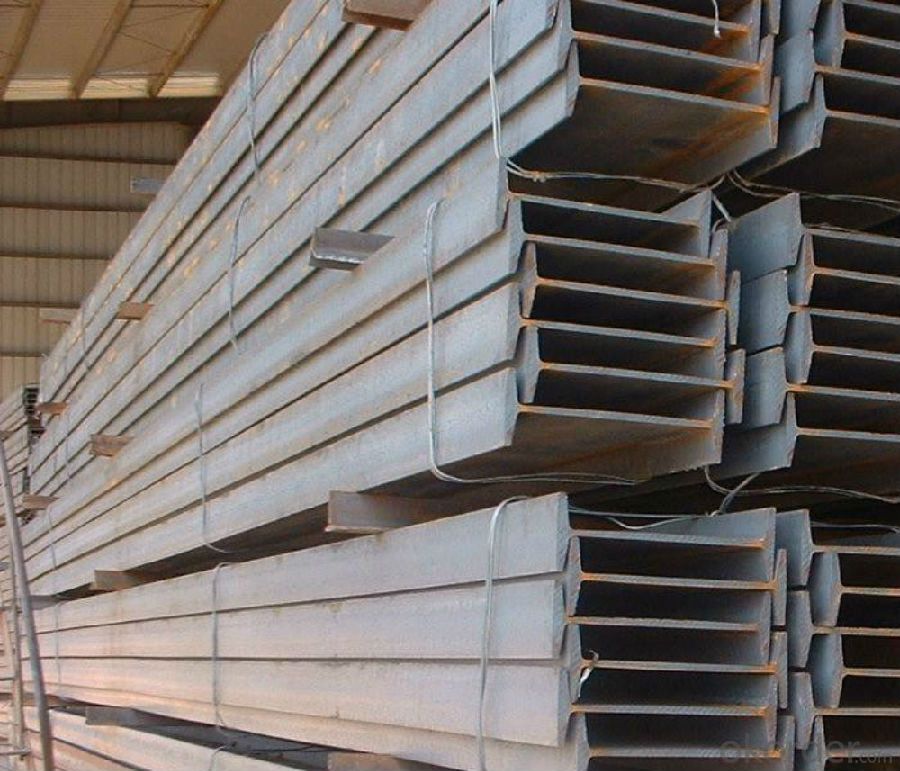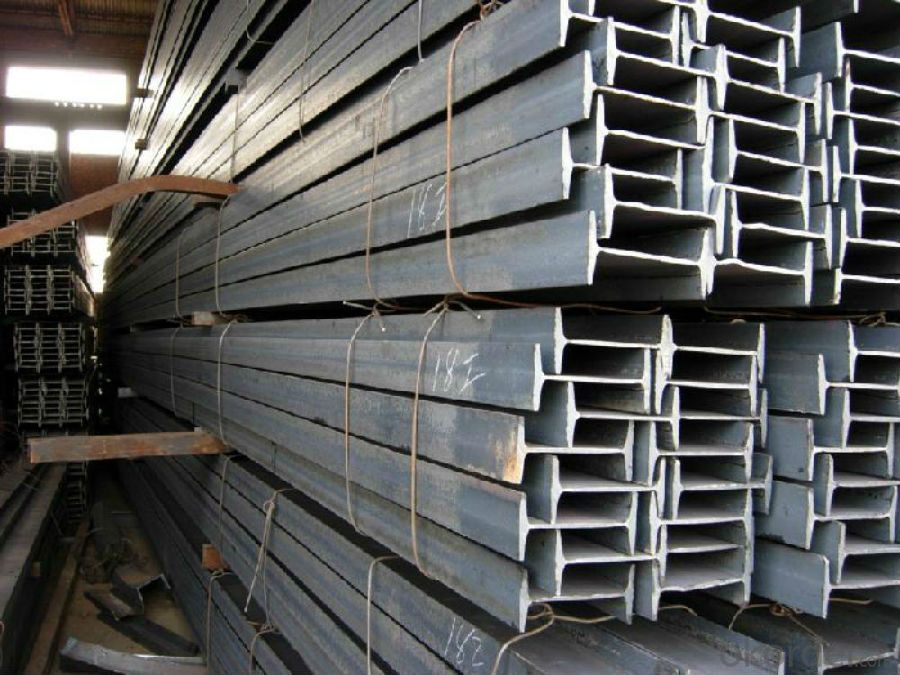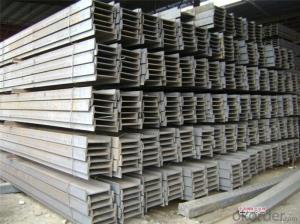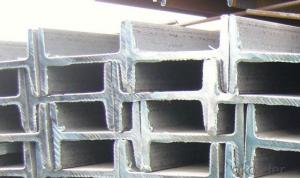Hot Rolled IPE and IPEAA Beam with Q235B Grade
- Loading Port:
- Tianjin
- Payment Terms:
- TT OR LC
- Min Order Qty:
- 25 m.t.
- Supply Capability:
- 10000 m.t./month
OKorder Service Pledge
OKorder Financial Service
You Might Also Like
Product Description:
OKorder is offering high quality Hot Rolled Steel I-Beams at great prices with worldwide shipping. Our supplier is a world-class manufacturer of steel, with our products utilized the world over. OKorder annually supplies products to European, North American and Asian markets. We provide quotations within 24 hours of receiving an inquiry and guarantee competitive prices.
Product Applications:
Hot Rolled Steel I-Beams are ideal for structural applications and are widely used in the construction of buildings and bridges, and the manufacturing, petrochemical, and transportation industries.
Product Advantages:
OKorder's Steel I-Beams are durable, strong, and resist corrosion.
Main Product Features:
· Premium quality
· Prompt delivery & seaworthy packing (30 days after receiving deposit)
· Corrosion resistance
· Can be recycled and reused
· Mill test certification
· Professional Service
· Competitive pricing
Product Specifications:
Manufacture: Hot rolled
Grade: Q195 – 235
Certificates: ISO, SGS, BV, CIQ
Length: 6m – 12m, as per customer request
Packaging: Export packing, nude packing, bundled
Chinese Standard (H*W*T) | Weight (Kg/m) | 6m (pcs/ton) | Light I (H*W*T) | Weight (Kg/m) | 6m (pcs/ton) | Light II (H*W*T) | Weight (Kg/m) | 6M |
100*68*4.5 | 11.261 | 14.8 | 100*66*4.3 | 10.13 | 16.4 | 100*64*4 | 8.45 | 19.7 |
120*74*5.0 | 13.987 | 11.9 | 120*72*4.8 | 12.59 | 13.2 | 120*70*4.5 | 10.49 | 15.8 |
140*80*5.5 | 16.89 | 9.8 | 140*78*5.3 | 15.2 | 10.9 | 140*76*5 | 12.67 | 13.1 |
160*88*6 | 20.513 | 8.1 | 160*86*5.8 | 18.46 | 9 | 160*84*5.5 | 15.38 | 10.8 |
180*94*6.5 | 24.143 | 6.9 | 180*92*6.3 | 21.73 | 7.6 | 180*90*6 | 18.11 | 9.2 |
200*100*7 | 27.929 | 5.9 | 200*98*6.8 | 25.14 | 6.6 | 200*96*6.5 | 20.95 | 7.9 |
220*110*7.5 | 33.07 | 5 | 220*108*7.3 | 29.76 | 5.6 | 220*106*7 | 24.8 | 6.7 |
250*116*8 | 38.105 | 4.3 | 250*114*7.8 | 34.29 | 4.8 | 250*112*7.5 | 28.58 | 5.8 |
280*122*8.5 | 43.492 | 3.8 | 280*120*8.2 | 39.14 | 4.2 | 280*120*8 | 36.97 | 4.5 |
300*126*9 | 48.084 | 3.4 | 300*124*9.2 | 43.28 | 3.8 | 300*124*8.5 | 40.87 | 4 |
320*130*9.5 | 52.717 | 3.1 | 320*127*9.2 | 48.5 | 3.4 | |||
360*136*10 | 60.037 | 2.7 | 360*132*9.5 | 55.23 | 3 |
FAQ:
Q1: Why buy Materials & Equipment from OKorder.com?
A1: All products offered byOKorder.com are carefully selected from China's most reliable manufacturing enterprises. Through its ISO certifications, OKorder.com adheres to the highest standards and a commitment to supply chain safety and customer satisfaction.
Q2: What makes stainless steel stainless?
A2: Stainless steel must contain at least 10.5 % chromium. It is this element that reacts with the oxygen in the air to form a complex chrome-oxide surface layer that is invisible but strong enough to prevent further oxygen from "staining" (rusting) the surface. Higher levels of chromium and the addition of other alloying elements such as nickel and molybdenum enhance this surface layer and improve the corrosion resistance of the stainless material.
Q3: Can stainless steel rust?
A3: Stainless does not "rust" as you think of regular steel rusting with a red oxide on the surface that flakes off. If you see red rust it is probably due to some iron particles that have contaminated the surface of the stainless steel and it is these iron particles that are rusting. Look at the source of the rusting and see if you can remove it from the surface.
Images:



- Q:What are the different types of steel connections used for Steel I-Beams in industrial plants?
- There are several types of steel connections commonly used for Steel I-Beams in industrial plants. These connections are essential for ensuring the stability and structural integrity of the beams in various applications. Some of the different types of steel connections used include: 1. Welded connections: This is one of the most common types of connections used for Steel I-Beams. In this method, the beams are joined together by welding the flanges and webs of the beams. Welded connections provide excellent strength and rigidity, making them suitable for heavy-duty applications. 2. Bolted connections: Bolted connections involve using bolts and nuts to connect the I-Beams. This type of connection offers flexibility in terms of disassembling and reassembling the beams if required. Bolted connections are relatively easier to install and can be adjusted or replaced easily. 3. Riveted connections: Similar to bolted connections, riveted connections use rivets instead of bolts and nuts. Rivets are inserted through pre-drilled holes in the flanges and webs of the I-Beams and then hammered to secure them in place. Riveted connections provide high strength and durability, but they are less commonly used nowadays due to the labor-intensive installation process. 4. Moment connections: These connections are specifically designed to transfer bending moments between steel I-Beams. Moment connections are crucial in industrial plants where the beams are subjected to heavy loads and require additional support to resist bending. They are typically achieved by welding or bolting specialized components, such as end plates or beam seats, to the I-Beams. 5. Shear connections: Shear connections are used to transfer shear forces between the I-Beams. These connections ensure that the beams can withstand lateral or horizontal forces effectively. Shear connections can be achieved through welding, bolting, or a combination of both. 6. Gusset plate connections: Gusset plate connections involve the use of a steel plate, known as a gusset plate, to connect the I-Beams. The gusset plate is typically welded or bolted to the flanges and webs of the beams, providing additional strength and stability to the connection. Each type of steel connection has its advantages and disadvantages, and the appropriate choice depends on factors such as the load requirements, design considerations, and construction methods. Professional structural engineers and steel fabricators usually determine the most suitable connection type based on the specific needs of the industrial plant.
- Q:How do steel I-beams handle lateral loads, such as wind or earthquakes?
- Steel I-beams have been purposely designed to effectively withstand lateral loads, such as wind or earthquakes. The I-shaped cross-section of these beams imparts exceptional structural strength and rigidity, making them ideal for withstanding horizontal forces acting perpendicular to their length. Regarding wind loads, the shape of the I-beam aids in evenly distributing the force along its length, thereby minimizing the likelihood of localized failure. The top and bottom flanges of the beam are specifically engineered to resist bending moments and shear forces, while the web, connecting the flanges, facilitates load transfer between them. By combining these components, an efficient load-carrying system is achieved, effectively countering lateral forces produced by wind. Similarly, when confronted with earthquakes, steel I-beams demonstrate their aptitude in handling resultant lateral ground movements. The inherent stiffness of steel, in conjunction with the I-beam's shape, allows for dissipation of seismic energy through flexion and deformation rather than collapse. The I-beam's ability to distribute the load uniformly along its entire length diminishes concentrated stress at any particular point, thus rendering it more resistant to seismic events. To further enhance the capacity of I-beams to handle lateral loads, engineers may incorporate additional design features. These may encompass bracing systems, such as diagonal or cross-bracing, which further fortify the beam against lateral forces. Additionally, ensuring comprehensive load paths and augmenting overall structural integrity can be achieved by appropriately fastening and connecting the I-beams to other structural elements, such as columns and foundations. In summary, steel I-beams possess the requisite strength, shape, and capacity to distribute and dissipate forces, making them highly suitable for handling lateral loads like wind or earthquakes. Consequently, they are frequently favored in construction projects where resilience against these types of loads is imperative.
- Q:What are the load-bearing capacities of steel I-beams?
- The load-bearing capacities of steel I-beams can vary depending on their size, shape, and material grade. However, on average, steel I-beams can typically support significant loads ranging from a few thousand pounds to several hundred thousand pounds. It is essential to consult engineering tables or professionals to determine the specific load-bearing capacity of a particular steel I-beam.
- Q:Do Steel I-Beams require special handling during installation?
- Yes, Steel I-Beams do require special handling during installation. They are heavy and cumbersome, so proper lifting equipment and techniques are essential to ensure safe and precise placement. Additionally, careful attention must be given to their structural integrity and alignment to prevent any potential damage or compromise to the overall stability of the structure.
- Q:How do steel I-beams perform in terms of seismic isolation?
- Steel I-beams are widely used in construction due to their strength and durability. However, when it comes to seismic isolation, steel I-beams do not perform as effectively as other structural systems specifically designed for seismic resistance. One of the main reasons for this is that steel I-beams do not have inherent flexibility or damping characteristics, which are crucial for absorbing and dissipating the energy generated during an earthquake. During seismic events, the lateral forces and ground accelerations can cause significant stress on steel I-beams, leading to deformation and potential failure. In contrast, seismic isolation systems are specifically engineered to minimize the transmission of seismic forces to the superstructure. These systems typically include devices like isolators, dampers, or base isolators that provide flexibility and energy dissipation, effectively isolating the structure from the ground motion. While steel I-beams can be designed to resist seismic forces by incorporating additional measures such as cross-bracing or moment frames, they are not as effective as dedicated seismic isolation systems. These additional measures can increase the overall stiffness of the structure, potentially leading to higher forces transmitted to the building and its occupants during an earthquake. In summary, while steel I-beams are strong and commonly used in construction, they are not specifically designed for seismic isolation. For structures in seismic-prone areas, it is advisable to consider dedicated seismic isolation systems that are specifically engineered to provide superior performance and protection during seismic events.
- Q:Can steel I-beams be used for mezzanines and platforms?
- Steel I-beams are certainly suitable for constructing mezzanines and platforms. They are actually one of the most commonly used and preferred options for these purposes due to their strength and durability. Known for their capability to bear heavy loads and provide structural stability, steel I-beams are perfect for building elevated spaces like mezzanines and platforms. Moreover, they can be easily tailored and manufactured to meet the specific requirements and dimensions of the desired mezzanine or platform design. All in all, steel I-beams provide a dependable and enduring solution for creating robust and safe elevated areas.
- Q:How do steel I-beams perform in areas with high levels of air pollution?
- Steel I-beams are generally very durable and resistant to corrosion, which makes them well-suited for areas with high levels of air pollution. However, the specific performance of steel I-beams in such areas can be influenced by several factors. One of the main concerns in areas with high air pollution is the presence of corrosive substances in the air, such as sulfur dioxide and nitrogen dioxide. These pollutants can lead to the formation of corrosive compounds on the surface of steel, which can weaken the beams over time. However, steel I-beams are often coated with protective layers, such as paint or galvanization, to prevent direct contact between the steel and the corrosive agents. This coating acts as a barrier, reducing the risk of corrosion and enhancing the performance of the beams in polluted environments. Additionally, the design and quality of the steel used in the I-beams can also affect their performance in areas with high air pollution. Steel with higher levels of corrosion resistance, such as stainless steel or weathering steel, can be used in these environments to provide better protection against corrosion. Proper maintenance and regular inspections are also essential to ensure the long-term performance of steel I-beams in polluted areas. Any signs of corrosion or damage should be promptly addressed to prevent further deterioration. In conclusion, steel I-beams are generally well-suited for areas with high levels of air pollution due to their durability and resistance to corrosion. However, the specific performance can vary depending on factors such as the presence of protective coatings, the quality of the steel, and proper maintenance. By considering these factors and taking appropriate measures, the performance and lifespan of steel I-beams can be effectively maintained in areas with high air pollution.
- Q:Can steel I-beams be used for overhead garage doors?
- No, steel I-beams cannot be used for overhead garage doors. Steel I-beams are typically used for structural support in buildings and are not designed to support the weight and movement of a garage door. Overhead garage doors require specialized tracks and springs to properly function, and using steel I-beams in place of these components would compromise the safety and functionality of the door. It is essential to follow the manufacturer's specifications and guidelines when installing or repairing garage doors to ensure proper operation.
- Q:Are steel I-beams compatible with other building materials?
- Yes, steel I-beams are compatible with other building materials. Steel is a versatile construction material and is commonly used in combination with other materials in construction projects. Steel I-beams can be easily integrated with materials such as concrete, wood, glass, and even other metals. They are often used as load-bearing structural elements in buildings and can provide support for other materials, allowing for a wide range of design possibilities. Additionally, steel I-beams can be easily customized and fabricated to fit specific project requirements, making them a popular choice for architects and engineers. Overall, steel I-beams offer compatibility with various building materials, making them a flexible and reliable choice for construction projects.
- Q:How do steel I-beams perform in areas with high levels of chemical exposure?
- Due to their inherent resistance to corrosion, steel I-beams are well-suited for areas exposed to high levels of chemicals. These I-beams are typically coated with protective layers, such as galvanized coatings or epoxy paint, creating barriers against chemical substances. This effectively prevents the steel from reacting with or being damaged by corrosive elements in the environment. In addition, the structural design of I-beams, with their sturdy shape and cross-sectional properties, enhances their ability to withstand chemical exposure. The I-shaped profile provides exceptional strength and load-bearing capacity, making them ideal for heavy industrial applications, including chemical processing plants, refineries, and wastewater treatment facilities. However, it is important to recognize that not all chemicals have the same impact on steel I-beams. Some highly acidic or alkaline substances, as well as certain solvents or aggressive chemicals, may still cause corrosion or deterioration of the protective coatings over time. Therefore, it is vital to carefully choose the appropriate steel type, protective coatings, and maintenance practices based on the specific chemicals present in the area. This ensures the long-term performance and durability of steel I-beams in such environments. Regular inspections, maintenance, and prompt repair of any coating damages or signs of corrosion are also recommended to prolong the lifespan of the I-beams and maintain their structural integrity.
1. Manufacturer Overview |
|
|---|---|
| Location | |
| Year Established | |
| Annual Output Value | |
| Main Markets | |
| Company Certifications | |
2. Manufacturer Certificates |
|
|---|---|
| a) Certification Name | |
| Range | |
| Reference | |
| Validity Period | |
3. Manufacturer Capability |
|
|---|---|
| a)Trade Capacity | |
| Nearest Port | |
| Export Percentage | |
| No.of Employees in Trade Department | |
| Language Spoken: | |
| b)Factory Information | |
| Factory Size: | |
| No. of Production Lines | |
| Contract Manufacturing | |
| Product Price Range | |
Send your message to us
Hot Rolled IPE and IPEAA Beam with Q235B Grade
- Loading Port:
- Tianjin
- Payment Terms:
- TT OR LC
- Min Order Qty:
- 25 m.t.
- Supply Capability:
- 10000 m.t./month
OKorder Service Pledge
OKorder Financial Service
Similar products
New products
Hot products
Related keywords




























